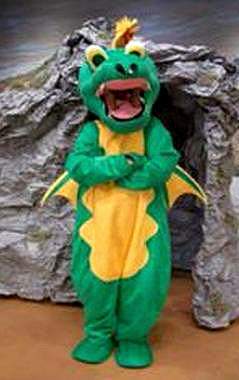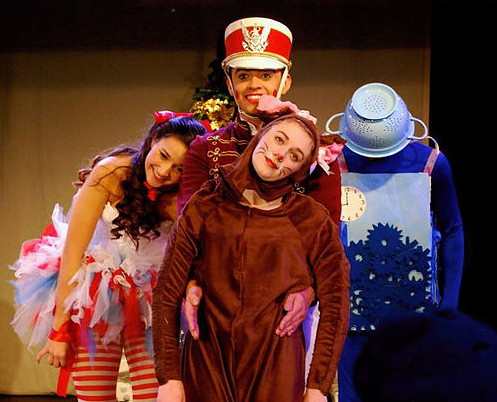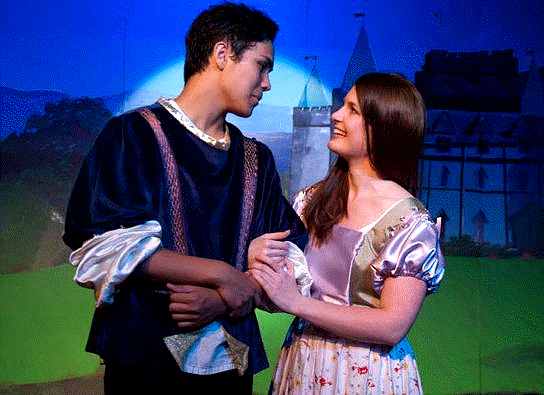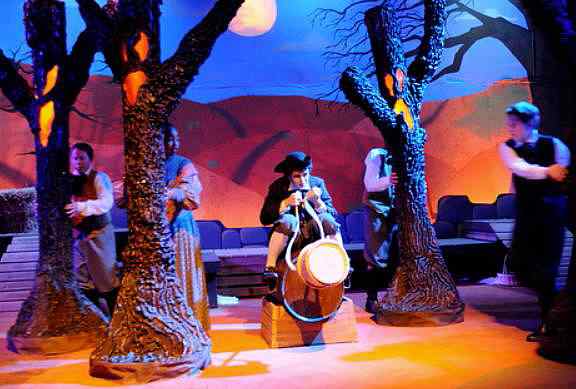
This page (Page
#5) has creative ideas
for directing a fun, successful play or musical. Check
out these examples used in ArtReach popular titles: Treasure
Island, A Christmas
Wizard of Oz, Sleepy Hollow, The
Reluctant Dragon, The Velveteen Rabbit, Glossary
of Theatre Terms. Don’t forget, a Teachers Guide will
come with your School Play Package and contain many other ideas and inspirations!

Kids
are Your Best Source of Creative Ideas
Stumped for
ideas? Ask your kids, it’s not cheating
Let your students help with
ideas for set, costumes and even blocking!
Sometimes during after-school
rehearsals your head goes – uh, duh&ldots; Your lead
character looks at you for direction and your ideas just aren’t
there. Why not ask the kids to help you out? When you hit
a low tide in the artistic flow, look around! You have
lots of imaginative minds just waiting for a chance to share!
Ask for their ideas!
Kids
are Your Best Source of Creative Ideas!

TREASURE
ISLAND: YOUNG PIRATES OF THE CARIBBEAN
Garden Island
School, Hawaii, Peggy Ellenburg Director
Teachers often call me and
want to know if the School Play Package includes lots of costume
ideas. I always answer, yes, of course! But I always add
that the kids who are actually playing the roles are your best source
of ideas.
As soon as the students have
had a chance to read the script and their parts, take a few moments
to speak to each child and coax out whatever visual mental images
they may have of their character. Often they will think of
things that are around their house like hats in a closet or keepsakes
in the attic or garage.
"Let
the kids create their characters in every way."



ArtReach's Treasure
Island - Drama Kids Charleston South SC
Ask them to describe what they
are thinking of and have them simply ask a parent if they can wear it
during the show. Ask also if the object can be embellished with
sparkly art supplies to jazz it up for the stage. This makes
your life so much easier and it gives kids a chance to do more than
just perform. After all, costume design is a creative part of
the process.
Why just assign this fun,
artistic adventure to their parents or volunteers to sew on a sewing
machine? Let the kids create their characters in every way and
they will feel much more invested in their performance. Active
participation in every artistic decision will give your kids a deeper
experience and yield a more expressive performance.
Letting kids decide takes the
pressure off of you and makes your job a joy!
ArtReach's
"A Christmas
Wizard of Oz" is easy to produce!
Here
are some practical suggestions for Holiday set and costumes.
Check
out these ideas for a stress free production of "A
Christmas Wizard of Oz":
Set
Pieces: Instead
of a backdrop, consider building or using small pieces that stand
alone, such as trees or doors that can be used in more than one
scene. A Christmas tree is all you need to set the story
in Kansas at Christmas time. For the Snowman scene you might bring on
just a section of picket fence which easily sets the scene in an
outdoor field. For the toys in Oz the PERFORMERS may
become toys themselves or they could hold their favorite toys or
stuffed animals brought from home.
Practical
tips for a successful Holiday play.


A
Christmas Wizard of Oz - Shawnee Playhouse, Shawnee On Hudson PA
You
will probably need some furniture pieces in the playing area.
You may use ordinary chairs and stools (anything that you have
available) to create "levels and scenes."
If
you have the resources, a backless bench and sturdy wooden boxes can
be built and painted fancifully to complement your costumes and other
set pieces. If you can't build pieces, be innovative - large
plastic flower pots make great stools, students can bring colorful
toys from home, etc. Have the students move these as
needed (ie, a bench can be used to elevate important characters above
the others).
The
pieces can moved around the area by CHORUS members or even by the
characters themselves. Often, just moving one piece to another
area of the playing area is enough to signal to the audience that
there is a change of scene.
If
you do decide to use backdrops I think its best to show a general
outside scene such as a landscape of blue sky and hills of snow,
perhaps dotted with Christmas trees. This will serve just fine
the whole play.
"Raid
the music room! Gather percussion instruments!"

A
Christmas Wizard of Oz - Shawnee Playhouse, Shawnee On Hudson PA
Performance
Space: If
the play is to take place in a classroom, move all the desks to the
back of the room. If this does not allow sufficient space for
the performance, push them against three sides and let the center of
the room be part of the playing area (with the audience, if any,
seated around). For a bigger audience, a larger room
would be appropriate. The gym or cafeteria will probably give
you more space than needed. In that case use just half of the
room and arrange audience chairs in a horseshoe shape around the
playing area.
Percussion
Instruments: Raid
the music room! Gather as many simple percussion instruments
as you can find (chimes, xylophones kazoos, whistles, rhythm sticks,
jingle bells, etc.) Create a "percussion stand" by
arranging the instruments on a table or a narrow ledge. Some
instruments will need to be held up to be played (triangle, chimes,
gong). The music room might have a stand for these
instruments. If not, you could build a simple one (think
"large cardboard box") or simply have the children hold
those up when they are played.
CHORUS
members (usually identified by different colors) could be seated
around the percussion stand. They can act as narrators and
orchestra in the tradition of a Greek Chorus. (Occasionally, CHORUS
members are given short on-stage tasks to do.) Your percussion
stand can be placed in the corner of the playing area.
Costumes:
There is a
Japanese theatrical tradition of dressing actors all in black and
using masks or costume pieces to indicate character. What a
great idea! Have your young performers wear all black or dark
blue - or dark purple, green, have them choose! They then add
costume pieces such as hats, crowns and capes to identify their characters.
Keep
it simple. Remember it's more important (and more fun!) for
your students to convey their character's personality through acting
rather than costume. CHORUS members can wear different color
tee-shirts to match their color-name or they can bring a piece of
clothing from home (ball cap, scarf, a towel used as a cape) that is
their color.
"Keep
it simple."


A
Christmas Wizard of Oz - Shawnee Playhouse, Shawnee On Hudson PA
Many
schools and theatres replicate the costumes seen in the famous
movie. But the book existed before the movie and it might be
fun to re-imagine some of the characters and how they might
look. Here are some suggestions for the Christmas version:
CHORUS:
They may all wear wool scarves and various kinds of hats that suggest
their particular color. It can be really fun to let them create
an entire character for their color and I've seen some wonderful
examples that include face painting, wigs and anything to be found
Grandma's closet. It can also be fun if they imitate well-known
school characters like the principal or the coach by wearing telltale
glasses, beards, wigs.
DOROTHY:
She can wear
the traditional blue dress but remember it's cold, so give her a cute
jacket, a fuzzy hat or any warm piece that indicates winter.
TOTO:
I think Toto is funniest with the slightest indication he's a dog,
like little ears on a ball cap or a tail Velcroed around his
waist. But I've seen wonderful flights of fancy such as and
entire dog suit with a dog head as part of the hood that sits atop
the actor's head. He can use a little red tie or bauble for Christmas.
"Let
them create an entire character."


A
Christmas Wizard of Oz - Shawnee Playhouse, Shawnee On Hudson PA
GLINDA:
She can be
dressed as a female Santa with red velvet cape and hood with white
fur trim. It is important that look very Christmasy since she's
the first character that appears in this unexpected Christmas Oz.
ELFINS:
The easy way
to go is to use elf ears that you can buy around Christmas. The
actors can decide what other Elfin features they'd like for their characters.
SNOWMAN:
The traditional classic Snowman is always appropriate but be careful
not to bog him down in a lot heavy stuff. He has a lot of work
to do in this play. One student wore a kind of fleece
jump suit and painted his face with glitter and spiked and sprayed
his hair with snow flocking.
TREES:
You can go with the actors holding just the branches with ornaments
on them which clearly indicates that they are trees. They
may have garlands of pine or Christmas garlands around their
necks. Someone can drape Christmas lights over the branches
just before they walk on. Also, the kids can make their own
tree costumes out of construction paper which works because they
don't have to move around too much.
"Witches
don't have to be female."


A
Christmas Wizard of Oz - Shawnee Playhouse, Shawnee On Hudson PA
TIN
SOLDIER:
Look at pictures of toy soldiers in books or on the Internet and
choose which one the actor would like most. Again, be careful
that he can move easily.
STUFFED
LION:
He can look like the traditional Cowardly Lion, but don't forget the
price tag!
MR.
JINGLES:
He's one of Santa's helpers so he can have an elaborate elf costume,
with lots of jingle bells and keys sewed onto his clothes.
FLYING
REINDEER:
Antlers are everywhere at Christmas. They can also wear
bracelets and anklets of jingle bells.
GROUCHY
GRUMBLE: She
can be the traditional Witch or you can go for something more
Grinchy for Christmas. And don't forget, she doesn't have to be
female. "She" could have a pot belly and a bald head
-- anything that says "grouchy" will work.
AUNTIE
EM & UNCLE HENRY:
They can look like the traditional farmers but remember to give them
hats and coats.
ArtReach
Halloween Plays are
for Kids
How to Minimize
the Scary and Maximize the Fun
If you are of a certain age
you may remember the first time you saw the movie, The Exorcist.
That movie and Hitchcock’s Psycho scared the bee-jeebies out of
me when I was a preteen. I remember how hard it was to turn out
the lights at night for fear of demons and crazies in the shadowy corners.
We all mature at a different
pace. For me, it was quite a while before I could watch a scary
movie and realize it was just make believe, therefore not actually
something to be afraid of. So it’s tricky when producing
Halloween plays for kids. Just how scary should it be?
The
Legend of Sleepy Hollow takes its cue from Washington
Irving’s original work. Give that story a close reading
and you will see that Irving meant the whole thing to be hilarious,
not terrifying. The comedy comes from Ichabod’s fear of
ghosts and never tries to frighten the reader. In
ArtReach’s The Legend of Sleepy Hollow your young audience will
scream at the first sight of the Headless Horseman and then laugh
their heads off at Ichabod’s reaction.
We offer the life of Edgar
Allan Poe in the play Poe!
Poe! Poe! Since it is offered as reader’s theatre,
this play emphasizes the literature and life of this great American
writer. Though stories such as the Masque of the Red
Death are dark, quite dark, the audience is left with an appreciation
of the writing, not the scariness of the story.
In
our newest Halloween play, Kid
Frankenstein, Frankie and Irving are science nerds who have an
unusual idea for the upcoming Science Fair. When Doctor
Frankenstein's ancient secret book arrives from Transylvania, the
friends are whisked into a sci-fi fantasy of time-warped, weirdly
scary and lively adventure.
However the kids feel about
scary movies these days, ArtReach’s Halloween plays are perfect
choices for young audiences.
How
to Dress Your Dragon
Creative tips
on how to make a fun
dragon costume.
There are many dragons in our
culture. You can find them in hundreds of medieval paintings
that depict the age-old myth of ‘St. George and the
Dragon’. You can find them in old and new children’s
books. You can even find them on the Disney Channel and in the movies!
Here are some excitingly
clever costumes that recently graced the stages of The Rose
Children’s Theatre in Eugene, OR, and Bremerton Community
Theatre Jr. in Washington State!
Train
your dragon in three easy steps!



Dragons in ArtReach's
The Reluctant Dragon
It’s a great idea to
leave the actor’s face open to the audience. Seeing both
faces, the audience will quickly meld the two giving you the best of
both worlds: A dragon face and the human expressions of your young
performer. Also, don’t forget your poor sweating performer
– make the costume as comfortable as possible.
Don’t let dressing your
dragon scare you away from presenting this lovable beast on your
stage! You will be surprised how effective a simple headpiece
and tail can be. Here are some examples of simple costumes that
will serve beautifully for comic and informal performances:
Never
forget to talk to your actor when making costume decisions.



A little work can go a long
way for clever performers!
Never forget to talk to your
actor when making costume decisions. You’ll be surprised
how many ideas they already have in their eager, creative heads!
They may actually know of something at home that they can fashion
into a costume. That makes it clever, easy and wonderful fun
for your young cast!
How
to Create Amazing Costumes Kids Love to Wear
Let your
all-kids cast do the creative work for you
We love all the great costume
ideas we’ve seen lately, especially for our new Christmas
Musical, THE VELVETEEN RABBIT.
Check out Robbie Robot on below on the right.
"Fun
Toy Costumes for Kids Christmas Musical."


Costumes in ArtReach's Musical The
Velveteen Rabbit -The Innovation Arts, Lexington KY - PACE
School NYC
You can make your directing
job a lot easier by asking kids to participate in the creativon of
their own costumes! Tell your young thespians to think about
how their character acts, talks and walks. Then have them go
home and look around for household objects that might be used in
bringing their character to life! You’d be surprised how their
imaginations are always turned on – a great resource for you to tap!
"Look
around for household objects."

Kids Make Imaginative Costumes
Get inspired by robot costumes
by Élena Nazzaro of French Toast Girl!
Glossary
of Theatre Terms
Theatre Stuff
for Directors!
Aesthetics:
The branch of philosophy that deals with theories of art and beauty.
Arena: Stage
in which the audience sits on all four sides (theatre in the round).
Audience:
One or more persons who observe actors in a scene or play in a
classroom or a theatre. In theatre education, audience is sometimes
loosely used to mean the reflective performer as well as classmates,
other students, faulty, or the public.
Black Box:
Adaptable playing space.
Blocking:
Stage movement including sitting, standing, entering, exiting, and crossing.
Character:
A person, animal, or entity in a story, scene, or play with specific
distinguishing physical, mental, and attitudinal attributes.
Character Analysis:
The exploration of internal and external traits, including character
histories, based upon given imaginary circumstances.
Characterization:
The process of exploring the physical, social, and psychological
aspects of a role in order to create a believable character.
Choreography: Planned
movement/dance in a play or musical.
Conflict: The
opposition of persons or forces that gives rise to the dramatic action.
Costume: An
actor's stage clothing.
Costumes:
Fancy or plain,
it's your choice!



Examples of Professional and
Easy Costumes - ArtReach's Princess
and the Pea & I
Think I Can
Costume Plot: The
organizational layout of costumes required for a play.
Cross:
An actor's movement from one part of the stage to another.
Cue:
A signal from the stage manager to actor, stage crew, props manager,
or lighting technician that some predetermined action, such as an
entrance, sound effects, scenery change, or lighting change, is
required. Also used by actors to mean the line immediately before
their own.
Curtain Call: An
opportunity for the actors to acknowledge the audience.
Curtain Speech:
Opening announcements that inform the audience of pertinent
information such as safety protocol and audience etiquette.
Dialogue: Words
spoken by the characters in a play to communicate their thoughts,
feelings, and actions.
Directing: The
process of guidance, both external and internal, incorporating the
development of leadership skills; the unification of a production
from its basic interpretation through all the acting and technical
phases up to the time of performance.
Drama:
Literature written in dialog form and intended for the theatre.
Although plays can be read for enjoyment and instruction, they come
most alive when acted on stage. The term drama also refers to any
serious, as opposed to humorous, play.
Dramatic Activities:
Such activities as pantomime, creative movement, improvisation,
creative drama, storytelling, choral speaking, story dramatization,
theme oriented drama, story theatre, readers' theatre, role playing,
theatre games, and puppetry.
Elements of
Drama: Six major elements of drama according to
Aristotle: plot, character, theme, dialogue, music, and spectacle.
Emotional
Recall (Memory): Emotional perceptions elicited
from past experiences which can be used in understanding, portraying,
and reflecting on the human condition and human behavior.
Ensemble:
The dynamic interaction and harmonious blending of the efforts of the
many artists involved in a dramatic activity or theatrical production.
Ensemble:
Everyone works together!

ArtReach's Blue
Horses, LAMB Caravan, Sioux City, IA
Flexible Staging:
Any space in which a play can be performed other than a theatre (i.e.
gymnasium, cafetorium, outdoors).
Focus:
The concept of guiding the attention of the players and audience to a
particular place or person at a given moment.
Improvisation:
A spontaneous scene or episode created by an actor or actors without
a script.
Lighting:
The illumination of the stage by means of artificial light.
Lighting Plot:
A diagram of the location of lighting instruments and their areas of focus.
Makeup: Cosmetics
used to change the appearance of the face and other exposed surfaces
on the body in order to emphasize characteristics appropriate to a role.
Monologue:
A speech within a play delivered by a single actor alone on stage.
Motivation:
The actor's justification for doing or saying something; answers the
question, "Why?"
Nonverbal Communication:
Communicating without words using facial expression, gestures, and
body language.
Objective:
A character's goal; answers the question, "What does a character want?"
Pantomime: Telling
a story through body movement, gesture, and facial expression;
action without words.
Period Play:
A play from an earlier time played in the style, costumes, and sets
representing the period it depicts.
Playwriting:
The act of creating the plot, theme, characters, dialogue, spectacle,
and structure of a play and organizing it into a script form.
Plot:
The structure of the action of the play; it is the arrangement of
incidents that take place on the stage as revealed through the action
and dialogue of the characters. Plot structure usually includes a
beginning, a middle, and an ending with a problem, complications, and
a resolution.
Projection: Control
of loudness so that even those in the last row can hear and
understand every word in the play.
Projection:
Speak up so everybody can hear!


ArtReach's The
Emperor's New Clothes
Prompt Book:
The stage manager's copy of the script in which the blocking and
technical cues are noted.
Props:
Properties; objects used by actors on stage (e.g., fan, wallet) or
objects necessary to complete the set (e.g., furniture, plants, books).
Proscenium: A
stage in which the audience sits in front as if looking in a picture frame.
Puppetry: The
animation of objects, ranging from hand puppets to marionettes,
creating characters in dramatic situations.
Reaction:
Response to stimulus presented by character, event, or environment.
Reader's Theatre:
A performance in which a play is read aloud with expression rather
than memorized off book.
Rehearsal: A
session in which the director and actors prepare a play for performance.
Role:
A part in a play; the character played by an actor in a play.
Scene:
The division of an act or of the play itself; the division may be
dictated by a change of time or place in the play.
Script: The
written dialogue, description, and directions provided by the playwright.
Set: All
the scenery, backdrops, set pieces, and props used to create a stage
environment for a dramatic performance; the performing area created
by those elements.
Set/Scenery:
Paint something wonderful
or just go with a black drop!



ArtReach's The
Legend of Sleepy Hollow, Alice
in Wonderland, The
Wizard of Oz
Setting: The
time and place in which the dramatic action occurs.
Stage Business:
Movements made to strengthen the personality of a character the
actor is portraying including props and/or costumes.
Subtext:
The unspoken meaning or intention behind the actions and dialogue of
a text or performance, which is implied largely by nonverbal behavior
and subtleties in vocal qualities.
Technical Theatre:
A branch of theatre that includes scenery, costumes, special effects,
sound, lighting, and props.
Theatre Games:
Group acting exercises frequently used for warm-up, motivation, and
exploration of character and subtext.
Theatre Management:
The administrative aspects of theatre (e.g., stage management,
budgeting, public relations, box office, house management).
Theme: The
central thought or idea of a play.
Thrust:
A stage surrounded on three sides by an audience.
Warm-up:
An activity in which the student focuses attention on limbering up
the body, voice, imagination, or intellect.
Directing Tips
Page 5: <
Prev | 1
| 2 | 3
| 4
| 5
| 6 | 7
| 8 | 9
| Next >
All
Free Resources
